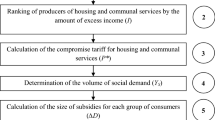Abstract
The conducted researches have shown that the features of the housing and communal sector do not allow talking about the possibility of calculating the “optimal” tariff rate. Also in the current conditions in Russia, tariff methods that are successfully used abroad (for example, the method of reinvested capital) cannot be used. The correct approach to housing and communal tariff formation is the calculation of compromise tariffs, the size of which takes into account the interests of consumers of services, resource-supply organizations, public authorities and investors. Development of an effective method of tariff formation for rural areas is particularly acute. The correct approach to housing and communal tariff formation is the calculation of compromise tariffs, the size of which takes into account the interests of services’ consumers, resource-supply organizations, public authorities and investors. Compromise approach for tariffs’ formation can also become an effective instrument not only in Russia: it can be applied in countries where it is sufficient to calculate housing and communal services’ social demand and its budget coverage (e.g. because of the increasing number of migrants).
Access this chapter
Tax calculation will be finalised at checkout
Purchases are for personal use only
Similar content being viewed by others
References
Jukic, B., Jukic, N., Parameswaran, M.: Data models for information sharing in e-partnerships: analysis, improvements, and relevance. J. Organ. Comput. Electron. Commer. 12, 175–195 (2002)
Lummi, K., Rautiainen, A.: Development options and impacts of distribution tariff structures. Tampere University of Technology, Filand, p. 65 (2017)
Zamotajlova, D., Kurnosova, N., Reznikov, V.: Methodological approaches to estimation of management organizations’ efficiency of activity in housing and communal sphere. Kuban State Agrarian University (2017)
Chan, H.K., Chan, F.T.S.: Effect of information sharing in supply chains with flexibility. Int. J. Prod. Res. 47, 213–232 (2009)
Davcik, N.S., Piyush, S.: Impact of product differentiation, marketing investments and brand equity on pricing strategies: a brand level investigation. Eur. J. Mark. 49, 760–781 (2015)
Alcalde, J., Peris, J.E.: Sharing costs and the compromise solution. University of Alicante, D. Quantitative Methods and Economic Theory (2017)
Ryahovskaya, A.: Government regulation of the economy in crisis. Scientific works of the Free Economic Society of Russia (2016)
Kardash, V.A.: Conflicts and Trade-Offs in a Market Economy. Nauka, Moscow (2006)
Zamotajlova, D., Popova, E., Gorkavoy, P., Nedogonova, T.: Compromise tariff formation as one of the bases of development of the housing and communal complex of rural areas. Kuban State Agrarian University (2018)
Author information
Authors and Affiliations
Corresponding author
Editor information
Editors and Affiliations
Rights and permissions
Copyright information
© 2019 ICST Institute for Computer Sciences, Social Informatics and Telecommunications Engineering
About this paper
Cite this paper
Pereira, J.P., Zamotajlova, D., Popova, E. (2019). Development of an Effective Method of Tariff Formation for Rural Areas: The Case of Russian Federation. In: Song, H., Jiang, D. (eds) Simulation Tools and Techniques. SIMUtools 2019. Lecture Notes of the Institute for Computer Sciences, Social Informatics and Telecommunications Engineering, vol 295. Springer, Cham. https://doi.org/10.1007/978-3-030-32216-8_42
Download citation
DOI: https://doi.org/10.1007/978-3-030-32216-8_42
Published:
Publisher Name: Springer, Cham
Print ISBN: 978-3-030-32215-1
Online ISBN: 978-3-030-32216-8
eBook Packages: Computer ScienceComputer Science (R0)




